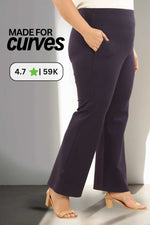Plus-size clothing has been gaining recognition for the value it deserves. Majority of women prefer plus-size as a clothing option to be comfortable, fashionable, and sleek. Despite the coeital delusions of zero-size women being fashion goddesses, the world has realized that beauty lies within all. This has inspired a whole range of clothing options for plus-size women and finding the right fit gets easier.
However, wherever there are options, you need to have the knack to compare and find the ideal choice that meets your requirements. In this case, it will be your body measurements. There are certain considerations that have been taken for plus-size clothing which will be discussed in the next part.

Considerations that needs to be taken for plus-size clothing
Many brands are opting for plus-size clothing and launching a whole new collection for women who compare to the plus-size clothing chart. However, there are certain implications that these brands need to consider for manufacturing plus-size clothing. For instance, brands need to check out the body measurements particularly the waist, bust, and chest.
This is important as fitting for women is dependent on these attributes. Ignoring these aspects can be problematic as unlike men, women’s fitting is not straightforward. Hence, brand’s meticulously consider this while creating a sizing chart that is standardized for oversize women. To better understand this, it is important that one understands the sizing systems and compare it later with modern plus-size sizing options.
Here are some of the three different sizing systems for plus-size
You would be surprised to know that there are multiple sizing systems for women. Yes, not just one but three different ones. Many prefer the former to the latter. Here is a quick look into it.
1) X Sizes
You are surely familiar with the X reference sizing option. This is majorly considered by most of the mainstream brands and it ranges from XS to XL. These days you can also find XXL and up to 8XL sizes. This sizing guide has been known to offer expected fit than others.

2) Women’s Sizes
Women’s sizes are symbolically represented as “W” size. This size is particularly for women and they are a generous loose fighting option. The sizing chart is catered for women who have curves or are over-sized. The guide is prepared to design clothing for plus-size women. In sizing, it is represented by adding plus or “+” in the suffix of the sizing.
3) Misses’ Sizes
It is likely that you have come across numbers such as 14, 18, 20, and others in sizing charts or measurements. Well, if you have it is considered as Misses' size. Some retailers are known to follow the Misses' size. They are mostly displayed portraying Youthful looks.

How is plus-size sizing different from mainstream sizing for women?
While shopping for plus-size clothing, it is possible that you can get perplexed by the variety of options that are present. For instance, sizing starts from 2XL and rises till 8XL. This spectrum of sizing can be difficult to understand at first particularly when you are shopping for the first time. The most ideal solution for you in this case is to look at the brand’s styling guide. Yes, a brand’s styling guide is your best friend in helping you understand the nitty gritties of plus-size clothing. This is one the ideal solutions that many consider using when they are perplexed about which size is right for them.
What are the various types of fits available in plus-size sizing?
Besides sizing, brands also have various types of fits to consider. This is important as in a particular size people have multiple preferences in their fits. You can better understand this by comparing it with the four different types of fits available for women.
1) Loose Fit
As the name suggests, Loose Fit is a type of fitting that is considered to be baggy. You will have much more room than the comfort fit. This is preferred by those who wish to have enough breathable space between the body and the fabric.
2) Oversize Fit
Oversize fit is considered to be a type of fit that does not stick to the body. It has no body definitions and can be altered or fitted by a tailor later on. It is best for women who don’t know a size that is compatible with their body type.
3) Comfort Fit
This is for those who prefer a leaner yet comfortable look. Comfort fit ensures that little space is present to give some room especially in areas like the waist, hip, and the chest. This fit is considered comfortable as it projects the body definitions without being too tight.
4) Relaxed Fit
Relaxed fit can also be considered as an average fit. Yes, it is a type of fitting that’s not too baggy or tight. It lies in the middle and so its name for an average fit. Majority of women prefer relaxed fit clothing options as it makes them feel relaxed.
Besides these, there are many more fitting types. Sometimes, it is not considered too important and is only used as reference for your fitting expectations.
How to find the perfect plus-size clothing for you?
It can be confusing at first to find the right fit for your body especially when your preferred size lies in the plus-size spectrum. It would help if you took measurements of your hips, waist, and chest as it will allow you to pick the right category. Besides, you could always experiment initially. Even if you mishap with your sizing in the beginning, you can always return the outfit. You also get a judgment on which size will better suit you. Therefore, this will give you the confidence to buy clothes for you and allow you to explore with various attires. However, remember that the first step is to get your body measurements right and look at the brand’s sizing guide.Outgoing Thoughts
It is important that you remember that beauty remains undefined. It is how you perceive it. For better or worse, you are your companion. Therefore, let it be inscribed in your heart.



























































